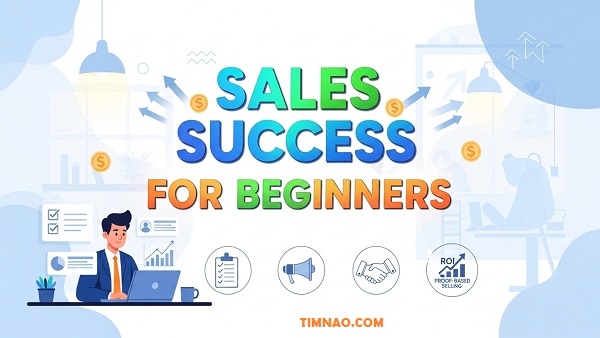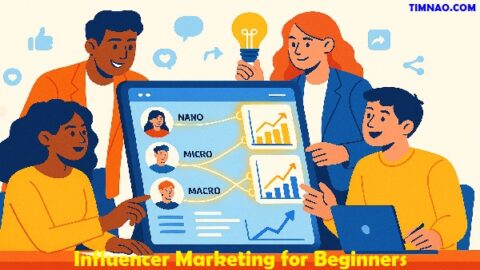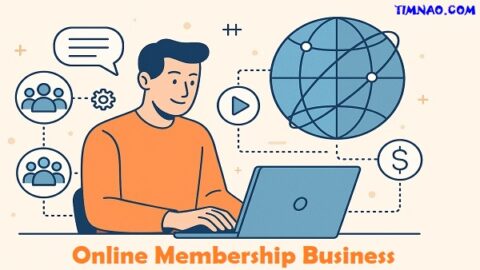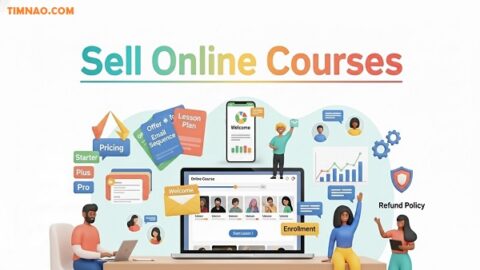Sales Success for Beginners: 21 Proven Steps for Confident, Fast Wins 🚀
Sales success for beginners isn’t about slick scripts or lucky breaks. It’s about building a few durable habits—listening, simplifying, preparing for pushback, and proving your claims—then repeating them consistently. In this guide, you’ll learn selling techniques you can use today, plus proof-based selling tactics that make your offer feel safe and valuable to a skeptical buyer. We’ll keep it practical, beginner-friendly, and grounded in what’s working right now.
Table of Contents
- 🎯 Mindset First: Becoming an “All-Weather” Seller
- 🛡️ Become Immune to “No” (Without Getting Pushy)
- 🧰 Use “Negative Preparation” to De-Risk Your Pitch
- 👂 Listen Like a Pro: The 5-Point Checklist
- 🧹 Avoid Contamination: Protect Your Attitude & Inputs
- 📦 Personal Packaging: How You Show Up Sells
- 📈 Expectation Engineering: Why Your Headset Matters in Sales Success for Beginners
- 🧾 Proof-Based Selling: Build an Overwhelming Case
- 🧩 K.I.S.S. Your Sales Process: Keep It Simple
- 💵 Sell Money at a Discount: Make ROI Obvious
- 🍊 Compare Apples to Oranges: Reframe Value
- 🎁 The Smart “Free Lunch”: Bonuses that Really Convert
- ✨ Create Positive Mystique (Even for “Boring” Offers)
- 🐸 Dumb & Persistent (in a Good Way)
- 🤝 “Be There” Beats Long Distance: High-trust Moments
- 📍 Stop Prospecting? Position Yourself Instead
- 🧲 Lead Magnets that Pull the Right People
- 🪜 A Beginner-Friendly 6-Step Sales Flow
- 🥏 Takeaway Selling: The Counterintuitive Close
- 🛠️ Tools Stack for Beginners (Links Included)
- ✅ Key Lessons & Takeaways
🎯 Mindset First: Becoming an “All-Weather” Seller
Most beginners enter sales with the idea that success depends on external factors—good timing, favorable markets, or easy-going customers. While those conditions help, they’re not reliable. Top performers succeed because they become “all-weather sellers”—capable of producing results in both stormy and sunny conditions.
An “all-weather” mindset means you don’t let tough circumstances control your output. Just like an athlete who trains in the rain and the heat, you prepare yourself to perform regardless of setbacks, objections, or slow markets. This resilience is often what separates the average rep from the consistent winner.
The Hidden Power of Resilience
When things are going well, nearly anyone can sell. But when prospects are cautious, budgets are tight, or delays are common, the ability to push through calmly is a competitive edge. Customers sense your confidence, and confidence is contagious. If you stay composed and proactive when others panic, you earn trust faster.
Build Your “All-Weather Kit”
Think of resilience as a toolkit you can carry into every sales conversation. For beginners, start with three essentials:
- Prepared responses to objections. Have a short script for the most common challenges like price, timing, or “I need to think about it.”
- Daily mindset reset. Before calls, pause for one minute, breathe deeply, and remind yourself: “I create outcomes, not excuses.”
- Micro-reflections. After each call, jot down one thing you did well and one thing you can improve. This simple ritual prevents you from getting stuck in self-doubt.
A Practical Exercise
Take a blank page and write down the three situations that usually rattle you—maybe it’s a cold prospect, a client who challenges your expertise, or silence after you give a price. For each, create one sentence you can lean on. For example:
- If someone says, “That’s expensive,” reply with: “I understand—it’s an investment, so let’s look at the return together.”
- If they delay: “I get it, timing matters. What would need to happen before this becomes a priority?”
- If they go quiet: “Can I check in—does this align with what you had in mind, or should we adjust?”
These short lines keep you calm and buy you time to think clearly.
Once you anchor yourself in the all-weather mindset, the next challenge is learning how to handle rejection without letting it drain your energy.
🛡️ Become Immune to “No” (Without Getting Pushy)
The word “no” feels heavy when you’re new. Many beginners see it as personal rejection, but in sales, “no” is simply information. It could mean the timing isn’t right, the value wasn’t clear, or the buyer still has unanswered questions. Understanding this distinction will help you treat rejection as data, not defeat.
Reframing “No” as “Not Yet”
Instead of hearing “no” as the end, think of it as “not now” or “not this.” Many deals that eventually close start with hesitation. When you shift your perspective, you remove the fear of asking again or following up later.
How to Respond Without Pressure
Pushiness turns people off, but silence kills momentum. The sweet spot is polite persistence. Here’s a simple three-step process:
- Acknowledge the concern. Show you heard them: “I understand this might not feel urgent right now.”
- Offer a small next step. Suggest something low-risk, like reviewing a case study or scheduling a short check-in.
- Create a calendar touchpoint. If they truly can’t move forward, ask: “Would it make sense for me to reach out again in a month?”
This keeps the door open without making the prospect feel pressured.
Build Your “No Immunity” Through Volume
The more conversations you have, the less one “no” matters. Set a goal to collect rejections—yes, collect them. For example: “I’ll make 20 calls today, and my target is at least 10 rejections.” This flips rejection into progress because every “no” gets you closer to the “yes.”
Beginner Challenge: Track Your Rejections
Create a small chart with three columns: Date | Prospect | Outcome. Every time you hear “no,” mark it. At the end of the week, look back—did some of those “nos” turn into follow-up opportunities? You’ll often find that what once felt like failure was actually just part of the normal sales rhythm.
When you no longer fear “no,” you’re free to engage boldly. But to win consistently, you also need to prepare for objections in advance, so you’re never caught off guard. That’s where negative preparation comes in.
🧰 Use “Negative Preparation” to De-Risk Your Pitch
Most beginners prepare for sales calls by memorizing product features or drafting talking points. That’s helpful, but incomplete. Real-world sales require negative preparation—anticipating what might go wrong so you’re ready with a calm, effective response.
Why Negative Preparation Works
Buyers are naturally skeptical. They’ve seen exaggerated promises, faced failed implementations, or wasted money on poor solutions. If you arrive unprepared for their doubts, you look inexperienced. But when you confidently address concerns before they escalate, you build credibility and reduce their perceived risk.
The Pilot’s Checklist Approach
Think of yourself like a pilot. Before takeoff, pilots don’t just check if the plane looks good—they review worst-case scenarios: fuel levels, weather conditions, emergency systems. You should do the same for your pitch. What are the five most common objections or breakdown points? List them, and have structured answers ready.
Common Beginner Objections and Responses
Here are a few examples to help you start your own list:
- Price is too high. → “I understand—it’s an investment. Can we walk through the potential return to see if it offsets the cost?”
- We don’t have time. → “That makes sense. Many clients felt the same until they realized our setup actually saves time within the first month.”
- We’re already using another provider. → “That’s great—what’s working well for you, and what’s still a challenge?”
- We need to think about it. → “Of course—decision-making takes time. What would you need to feel more confident moving forward?”
- We’re doing fine as we are. → “Glad to hear that. Can I share a quick example of how another client went from ‘fine’ to achieving [specific outcome]?”
Notice how each answer starts with empathy, then shifts the focus back to value.
Practical Exercise: Build Your Objection Bank
- Write down the top five objections you expect.
- Draft a one-paragraph response for each, following this structure:
- Empathize (“I understand…”)
- Provide proof or perspective (“Other clients found…”)
- Suggest a small step (“Would you like to see how this works in practice?”)
Keep these responses in a document or note app. Review them before calls so they’re fresh in your mind.
A Beginner’s Edge: Roleplay
If possible, practice with a friend or colleague. Have them play the “tough prospect” and throw objections at you. The more often you rehearse, the less likely you’ll freeze under real pressure.
With an all-weather mindset, resilience against rejection, and strong negative preparation, you’re no longer reacting to sales conversations—you’re leading them. This foundation sets you up perfectly for the next phase: mastering listening skills that uncover hidden opportunities.
👂 Listen Like a Pro: The 5-Point Checklist
Most sales problems don’t come from poor product knowledge—they come from poor listening. When beginners jump into pitching too quickly, they miss crucial details about what the buyer really wants. Great sellers understand that listening is more than being quiet while the other person talks—it’s about catching signals, asking better questions, and showing genuine engagement.
Why Listening Beats Talking in Sales
Buyers don’t care about every feature. They care about solving their own problems. If you listen well, they’ll reveal their pain points, priorities, and even how they define success. This information is gold—you can tailor your offer so it feels like a perfect fit instead of a canned pitch.
The 5-Point Listening Checklist
Here’s a simple system to keep you focused during calls. Beginners can keep it on a sticky note:
- Clear your head. Take a 10-second pause before the call to let go of distractions.
- Set a listening goal. Ask yourself: “What do I need to learn on this call?” Maybe it’s budget, timeline, or hidden obstacles.
- Spot leverage points. Pay attention to emotional words like “frustrating,” “urgent,” or “stuck.” These point to hot buttons you can revisit later.
- Show active engagement. Nod, paraphrase, or say, “So what I hear is…” to prove you’re tuned in.
- Capture exact phrases. Write down the buyer’s own words—using them later makes your pitch resonate more.
A Quick Practice Drill
After each call, grade yourself 1–5 on each checklist item. Did you clear your head? Did you pick up leverage points? This self-scoring habit builds awareness quickly. Within weeks, you’ll notice you interrupt less and understand more.
Once you’re listening deeply, you’ll hear not only opportunities but also negativity—fears, doubts, and even skepticism from others. Protecting yourself from these “contaminants” is the next step.
🧹 Avoid Contamination: Protect Your Attitude & Inputs
Sales is a mental game. Beginners often absorb doubt from co-workers, online forums, or even their own self-talk. This negativity—what we’ll call “contamination”—quietly lowers your energy and makes you second-guess yourself. If you want consistent results, you need to guard your mental inputs as carefully as you guard your pipeline.
How Contamination Creeps In
- From peers: Hearing “these leads are junk” every day makes you believe it.
- From media: Reading threads where everyone complains about tough customers can convince you the market is impossible.
- From yourself: After one bad call, you might start telling yourself you’re not cut out for this.
Each of these is like rust—it spreads if you don’t clean it fast.
Clean Up Your Inputs
Here’s how beginners can protect their mindset:
- Curate your feed. Unfollow or mute negative voices on social media. Instead, follow sales practitioners who share real wins and tactics.
- Choose better conversations. Spend time with peers who celebrate progress instead of complaining.
- Journal weekly wins. Even small victories—like handling an objection calmly—help you see proof that you’re improving.
Simple Mental Reset
Try this 2-minute routine:
- Write down one positive client outcome you helped create.
- Say it out loud as proof that you’re delivering real value.
This little ritual cleans your mental windshield so you can see the road ahead clearly.
Once you protect your mindset, it’s time to think about what the buyer sees. Because in sales, your “packaging”—the way you present yourself and your materials—is a sales tool in itself.
📦 Personal Packaging: How You Show Up Sells
First impressions matter, especially for beginners. Before you even speak, your personal packaging—your online profile, how you enter a meeting, the simplicity of your materials—tells the buyer if they should take you seriously. The good news? Packaging isn’t about being flashy; it’s about removing friction and signaling professionalism.
What Counts as “Packaging” in Sales
Think beyond clothing. Packaging includes:
- Your LinkedIn profile (headline, photo, tagline).
- The calendar invite you send (clear agenda, correct links).
- The one-pager or slide deck you use (clean, simple, not overloaded).
- The ease of next steps (a clear “Book a call” button or pre-set follow-up link).
When each of these is tidy and purposeful, prospects subconsciously trust you more.
Beginner Packaging Checklist
- Update your profile. Instead of “Sales Representative,” write: “Helping small businesses reduce software costs by 20%.”
- Polish your materials. Use Canva to create a one-page overview of your solution—keep it visual and outcome-focused.
- Simplify scheduling. Add a Calendly link in your emails so prospects can pick a time in seconds.
- Prepare your environment. If selling over video, ensure good lighting and a clean background—buyers notice.
Quick Example
Imagine two sellers. One sends a vague calendar invite (“Meeting with John”), opens the call with a messy slide deck, and struggles to find the contract afterward. The other sends a clear invite (“Agenda: Review your challenges + 2 solutions”), shares one clean visual, and follows up with a one-click proposal link. Which one would you trust?
When you listen like a pro, protect your mindset from negativity, and show up with sharp packaging, you’ve built a strong platform for credibility. From here, every conversation becomes easier because the buyer senses competence before you even pitch.
📈 Expectation Engineering: Why Your Headset Matters in Sales Success for Beginners
In sales, how you set expectations before a conversation often matters more than what you say during it. Beginners usually rush into a call without preparing the buyer, leaving them confused about what will happen. The result? Long, unproductive chats that rarely move forward. Expectation engineering solves this.
The Idea of Pre-Suasion
Before someone hears your pitch, they’re already forming judgments about you. Was your calendar invite clear? Did your opening message make sense? These small signals act like a “headset” the buyer wears—they shape how they hear everything that comes next. If you set expectations well, the buyer is more likely to engage positively.
How to Engineer Expectations Step by Step
- Send a short agenda. A day before the call, send a message:
“We’ll review your challenges, look at 2 examples of how others solved them, and leave 10 minutes for Q&A.” - Preview the outcome. Mention what success looks like:
“By the end of the call, you’ll know if this solution fits, and if so, we can schedule setup.” - Lower the risk. Emphasize that no big decision is needed:
“This is just an exploration—no pressure.”
A Beginner-Friendly Template
Subject: Quick agenda for our call
Body:
- Review your current challenge
- Share 2 client examples
- Q&A for anything unclear
- Next step if relevant
When a buyer sees this, they walk into the call relaxed, focused, and curious.
With expectations set, your words carry more weight. But weight alone isn’t enough—you also need proof that your promises are real. That’s where the next section comes in.
🧾 Proof-Based Selling: Build an Overwhelming Case
If you only tell prospects how good your offer is, they’ll doubt you. If you prove it, you win them over. Proof-based selling means stacking enough evidence that skepticism melts away. Beginners often underuse proof, but it’s your strongest weapon in a world where buyers are cautious.
Types of Proof-Based Selling You Can Apply
- Traditional Proof: certifications, years in business, client logos, case studies.
- Social Proof: testimonials, reviews, referrals, user numbers.
- Demonstration Proof: live demos, before-and-after photos, trial results.
- Contextual Proof: independent reports, third-party research, ROI calculators.
The best sellers combine these so the buyer feels surrounded by evidence.
How Beginners Can Start a “Proof Folder”
- Collect two testimonials (even short quotes) from past or current customers.
- Create a one-page case snapshot showing the challenge, solution, and result.
- Record a 90-second screen demo walking through your product.
- Build a simple ROI worksheet in Google Sheets that prospects can edit live with you.
Keep these in one folder so you can grab them instantly during calls.
Why Proof Beats Pressure
Buyers hate pushy tactics, but they love reassurance. Instead of saying, “Trust me, this works,” you show them someone like them already got results. Proof removes friction from decision-making.
Real-Life Example
Imagine you’re selling a project management tool. Instead of saying, “We’ll save you time,” show:
- A testimonial: “We cut weekly reporting from 5 hours to 30 minutes.”
- A live demo where you automate a report in 90 seconds.
- An ROI sheet showing savings of $1,200/month in labor.
Now the buyer isn’t deciding whether they trust you—they’re deciding whether they want the same results.
Of course, proof only works if it’s clear. If your sales process is messy or overwhelming, buyers can’t see the value. That’s why keeping it simple is the next step.
🧩 K.I.S.S. Your Sales Process: Keep It Simple
“K.I.S.S.” stands for Keep It Simple, Seller. Beginners often overwhelm buyers with too many options, features, or long explanations. Simplicity isn’t about dumbing things down—it’s about making the choice obvious.
Why Complexity Kills Deals
When a buyer faces too many choices, their brain freezes. They delay, ask for more time, or choose the cheapest competitor because it feels safer. A simple process helps buyers understand what’s happening and what to do next.
How to Simplify Your Sales Process
- Narrow options. Present no more than two packages: a “recommended” option and a lighter one.
- Focus on outcomes. Instead of listing 10 features, highlight 2–3 results the buyer cares about.
- Use visuals. A two-column comparison table is easier than paragraphs of text.
- Shorten proposals. Aim for one page: problem, solution, proof, next step.
A Beginner-Friendly Framework
Here’s a clean flow you can apply right away:
- Problem. Summarize their pain in their own words.
- Fit. Show the simplest solution that matches.
- Proof. Add a short story or demo.
- Next Step. Ask for a small, logical action (trial, follow-up, or setup call).
Quick Example
You sell digital marketing services. Instead of offering five packages with endless add-ons, give two options:
- Option A (Recommended): SEO + social media management.
- Option B (Lite): SEO only.
Frame them in a table, show one testimonial, and ask, “Which one feels closer to what you need?” That’s K.I.S.S. in action.
When you set expectations clearly, back up your claims with proof, and keep the process simple, you’re no longer just “selling.” You’re guiding buyers through an easy, low-stress decision. And that’s exactly what makes beginners stand out quickly.
💵 Sell Money at a Discount: Make ROI Obvious for Sales Success
When you strip sales down to its core, you’re not selling a product—you’re selling a return on investment (ROI). That’s why some experts call this principle “selling money at a discount.” If a customer invests $1,000 but sees $5,000 in return, the decision feels like common sense. Beginners who master this mindset stop sounding like pushy salespeople and start sounding like smart advisors.
Why ROI Sells Better Than Features
Features are interesting, but they don’t close deals. Buyers want to know: “How does this help me save money, make money, or avoid losing money?” When you frame your offer as a way to multiply value, suddenly price becomes less of an obstacle.
Beginner-Friendly ROI Formula
Here’s a simple calculation you can use with prospects:
- Identify one or two measurable benefits. Example: hours saved, leads gained, or costs reduced.
- Translate into numbers. If your software saves 3 hours a week per employee, and each hour costs $30, that’s $90 per week per employee.
- Project over time. Multiply by 4 weeks, then 12 months. That’s $4,320 annual savings per person.
- Compare to price. If your product costs $1,200 a year, that’s essentially buying $4,320 at a discount.
Selling Technique: Let the Buyer Do the Math
Instead of presenting your own big ROI numbers, involve the buyer. Share a simple Google Sheet and let them plug in their costs and estimates. When they calculate the return themselves, they trust the result more.
Making ROI clear turns your offer into a no-brainer. But sometimes buyers will still compare you to cheaper alternatives. That’s when you need to reframe the comparison itself.
🍊 Compare Apples to Oranges: Reframe Value with Selling Techniques
One of the biggest beginner mistakes in sales is accepting the buyer’s frame of comparison. If they look at your solution next to a lower-priced competitor and only compare on cost, you lose. The key is to expand the frame so it’s no longer “apples to apples” but “apples to oranges.”
Why You Shouldn’t Compete on Price Alone
Price-only comparisons ignore value. If your competitor charges $50 less but doesn’t include onboarding, support, or training, the real cost to the customer could be much higher. By highlighting your added dimensions, you make it clear the comparison is unfair.
How to Reframe the Buyer’s Perspective
- Add hidden costs. Point out what the cheaper option doesn’t include.
- Highlight speed. Show how your solution gets them results faster.
- Emphasize risk reduction. Explain how your guarantee, reliability, or customer support lowers risk.
- Stack extras. Bundle in bonuses or services that increase perceived value.
Quick Example for Beginners
Imagine you’re selling a marketing package for $1,500, and a competitor offers one for $1,200. Don’t just say yours is “better.” Break it down:
- Competitor: one-size-fits-all ads, no reporting, email-only support.
- You: customized campaigns, weekly reporting calls, 24/7 live support.
Now it’s not just a $300 difference—it’s a completely different value package.
Selling Technique: The Value Stack
Create a one-page “Value Stack” graphic that shows:
- Base service
- Included extras (templates, onboarding, dedicated support)
- Unique elements (guarantees, community, speed to results)
This makes your higher price look like a bargain.
Once you’ve reframed value, you can make the deal even more attractive with strategic bonuses. But not all freebies work—some backfire. Let’s look at the right way to offer a “free lunch.”
🎁 The Smart “Free Lunch”: Bonuses That Really Convert
Free bonuses can make an offer irresistible—but only if they’re specific and valuable. Beginners often throw in vague freebies like “unlimited support,” which prospects don’t understand or believe. A smarter approach is to craft bonuses that feel concrete, limited, and directly connected to the buyer’s goals.
Why Specific Bonuses Work Better
Specificity increases perceived value. “Three onboarding sessions (worth $900)” sounds far more attractive than “ongoing support.” Buyers want to know what they’re getting and how it helps them succeed.
Beginner-Friendly Bonus Ideas
- Checklists & templates. Give them a plug-and-play tool they can use immediately.
- Exclusive training. A short workshop or video series focused on a key skill.
- VIP onboarding. Three guided sessions with clear milestones.
- Private resources. Access to a members-only library with tutorials or calculators.
The Right Way to Present Bonuses
- Assign a value. If your template pack is worth $450, say so.
- Make it time-bound. “Available for sign-ups this month only.”
- Tie it to outcomes. Explain how the bonus speeds results or reduces effort.
Example of a Strong Offer
Main offer: Website redesign for $3,000.
Bonuses:
- SEO checklist ($200 value)
- 2 strategy calls ($500 value)
- Launch-day support ($300 value)
Framed this way, buyers feel like they’re getting $1,000+ extra value, which tips the scale toward saying yes.
By combining clear ROI, smart reframing, and high-value bonuses, you create offers that feel safe, attractive, and even exciting. That’s how beginners move from nervous selling to confident closing.
✨ Create Positive Mystique for Sales Success (Even for “Boring” Offers)
Many beginners struggle with offers they think are “boring.” You might sell bookkeeping, insurance, or IT support—services people need but rarely get excited about. Here’s the truth: nothing is boring if you frame it with positive mystique. Mystique makes your offer stand out, feel meaningful, and spark curiosity.
Why Mystique Works in Selling Techniques
People love stories, symbols, and unique names. Mystique turns plain solutions into memorable ones. For beginners, this is one of the easiest selling techniques to learn: package your work with a story or method name, and suddenly you’re no longer just another provider.
Beginner-Friendly Ways to Create Mystique
- Name your method. Instead of “monthly reporting,” call it the “30-Minute Cash Clarity™ Report.”
- Tell an origin story. Share why you created your process or how a client first used it.
- Offer a meaningful guarantee. Something like, “Go live in 14 days or your first month is free.”
- Add symbols. A logo, diagram, or step-by-step framework creates a sense of uniqueness.
Real Example
A local accountant once rebranded their package as “The Profit Clarity System.” Same service, but with a name and story. Clients suddenly felt they were buying into a proven system, not just paying for number-crunching. That’s mystique in action.
Mystique draws people in. But attraction isn’t enough—you also need persistence. Let’s look at how being “dumb and persistent” in the right way can accelerate sales success for beginners.
🐸 Dumb & Persistent: Selling Techniques for Beginners
In sales, persistence often wins. Yet beginners either give up too soon or push too aggressively. The trick is to be “dumb” in the sense of not overthinking rejection, while staying persistent in a structured, respectful way.
Why Persistence Builds Sales Success for Beginners
Research shows that most deals require multiple touches before closing. Beginners who give up after one or two “no’s” miss opportunities. By treating rejection as normal and following a planned sequence, you dramatically increase your closing rate.
A Beginner-Friendly Follow-Up Sequence
Here’s a simple, non-pushy sequence anyone can use:
- Day 1: Send a thank-you email with a recap of the discussion.
- Day 3: Leave a short voicemail: “Just shared a resource that might help—check your inbox.”
- Day 5: Send that resource (case study, checklist, or ROI sheet).
- Week 2: Share a 60-second video: “Here’s how a client like you achieved X.”
- Week 3: Send a light nudge: “Should I pause or continue following up?”
This sequence keeps you in the buyer’s mind without being annoying.
The Power of Emotional Detachment
Being “dumb” here means you don’t take rejection personally. You simply keep following the process. Each touch is just another chance to build familiarity and trust. Over time, prospects who ignored you may respond simply because you stayed consistent.
Proof-Based Selling in Follow-Up
Don’t just repeat the same message. Each follow-up should include proof: a testimonial, a quick stat, or a mini case study. That way, every message adds value instead of feeling like spam.
Persistence keeps the door open. But when it’s time for important conversations, persistence isn’t enough—you also need presence. That’s why “being there” still matters more than distance selling.
🤝 “Be There” Beats Long Distance: High-Trust Sales Success Moments
Digital selling is powerful, but there are times when nothing beats being present—either physically or in a high-touch virtual setting. Beginners often hide behind email, but trust grows fastest when you “show up” with real presence.
Why High-Trust Moments Matter
Buyers don’t just evaluate your product; they evaluate your reliability. Seeing your face, hearing your tone, and experiencing your commitment firsthand builds confidence. When stakes are high—like negotiations, onboarding, or complex decisions—being there accelerates trust.
Beginner-Friendly Ways to “Be There” Without Traveling
- Use video calls. Always turn your camera on—it shows respect and professionalism.
- Share screens. Walk prospects through a demo or ROI sheet live instead of sending a file.
- Schedule live read-throughs. Present proposals in real time to catch questions early.
- Host kickoff calls. Celebrate the start of a partnership instead of just sending paperwork.
Real Example
A beginner consultant once lost deals because they emailed long proposals and waited. When they switched to scheduling a 20-minute live proposal review, their closing rate doubled. Why? Buyers could voice concerns instantly instead of quietly dropping off.
When to Go In-Person
If the deal is large, complex, or strategic, and you can meet in person, do it. An in-person lunch or workshop can establish a bond that email never will. Even for beginners, showing this effort signals you’re serious about the relationship.
Selling Technique: Presence as Differentiator
Most competitors will take the “lazy” route: sending emails, PDFs, or generic videos. By being there—whether virtually or physically—you stand out as the seller who actually cares. That small difference often wins the deal.
📍 Stop Prospecting? Position Yourself for Sales Success
When beginners think of sales, they often imagine endless cold calls, walking door-to-door, or blasting emails to strangers. That’s prospecting in its rawest form—and while it has its place, it’s exhausting, inefficient, and discouraging for most new sellers. A smarter path is positioning yourself so the right people come to you.
Why Positioning Beats Prospecting for Beginners
Positioning turns the tables. Instead of chasing prospects who don’t know you, you build visibility, credibility, and trust in places where your ideal buyers already spend time. Over time, this attracts warmer leads, reduces rejection, and creates a steady pipeline. That’s sustainable sales success for beginners.
Core Principles of Positioning
- Choose your audience. Get specific—“small business owners in fitness” is better than “anyone who needs marketing.”
- Clarify the outcome. Don’t just say what you do—say the result you create. For example: “Helping Shopify stores boost repeat sales by 20% in 90 days.”
- Show up consistently. Share short, useful content where your audience hangs out (LinkedIn, local meetups, niche forums).
- Offer proof early. Case snippets, quick demos, or testimonials build authority even before the sales conversation begins.
Beginner-Friendly Positioning Steps
- Update your LinkedIn headline. Make it outcome-driven, not job-title-driven.
- Publish one weekly tip. Keep it short, practical, and problem-focused.
- Engage with comments. Reply thoughtfully to posts in your niche—visibility grows faster this way.
- Speak locally. Offer a short workshop or webinar at a chamber of commerce or coworking space.
Example of Positioning in Action
Imagine two beginners selling website design. One spends hours cold-emailing random businesses, hoping for replies. The other posts weekly “before-and-after website makeovers” on LinkedIn, shares a checklist for better conversions, and gets invited to speak at a small business meetup. Who do you think gets warmer leads without burning out?
Once you stop exhausting yourself with cold prospecting and start positioning, the next step is creating tools that attract prospects automatically. That’s where lead magnets come in.
🧲 Lead Magnets That Pull the Right People with Selling Techniques
Positioning builds visibility, but you also need a way to capture interest and start conversations. That’s the job of a lead magnet. A lead magnet is a free resource that solves a small but meaningful problem for your target audience. Done right, it builds trust and earns you permission to follow up.
Why Lead Magnets Work in Sales Success for Beginners
Think of a lead magnet as a handshake. Instead of asking strangers to buy right away, you offer something helpful in exchange for their email or attention. This builds a list of people who have already shown interest, making follow-ups smoother and more effective.
What Makes a Strong Lead Magnet?
- Quick to consume. Avoid 50-page ebooks—busy people won’t read them. Aim for something they can use in 10–15 minutes.
- Directly relevant. The magnet should be tied to the problem your paid offer solves.
- Actionable. Give them something they can apply right away to see results.
- Specific. Instead of “Marketing Guide,” offer “5 Email Templates That Boost Open Rates.”
Beginner-Friendly Lead Magnet Ideas
- Checklists. “10-Point Website Health Checklist.”
- Calculators. “ROI Calculator for Facebook Ads.”
- Templates. “Discovery Call Script for Busy Entrepreneurs.”
- Mini-guides. “7 Quick Fixes for Better SEO Rankings.”
- Short training. A 10-minute video walking through a common mistake and its fix.
Selling Technique: Tie the Magnet to Your Paid Offer
Your lead magnet should naturally set up your solution. For example, if you sell bookkeeping services, a magnet like “5 Common Tax Mistakes Small Businesses Make” leads perfectly into your paid service: helping avoid those mistakes.
How to Deliver and Use Lead Magnets
- Create a simple landing page. Use Canva or Carrd for a one-page opt-in.
- Automate delivery. Tools like Mailchimp or HubSpot automatically send the resource once someone signs up.
- Follow up with proof. After delivering the magnet, send a testimonial, case snippet, or ROI example (this is proof-based selling in action).
Real Example
A beginner consultant offered a free “15-Minute Marketing Audit” checklist on LinkedIn. Every download collected an email. Over a few weeks, dozens of small businesses signed up. When the consultant followed up with a simple, “Want me to help you apply this checklist?” many said yes. That’s the power of a well-placed lead magnet.
When you shift from cold prospecting to positioning, and back it up with strong lead magnets, you create a system where prospects find you, trust you, and invite you in. That’s the foundation of long-term sales success for beginners.
🪜 A Beginner-Friendly 6-Step Sales Flow for Sales Success
One of the most common struggles beginners face is not knowing what to do next in a sales conversation. You get a lead—then what? You deliver your pitch—then what? Without a structured flow, beginners often get lost, skip important steps, or overwhelm the buyer with too much information. That’s why a simple, repeatable 6-step sales flow can make all the difference.
This framework is beginner-friendly, works across industries, and focuses on guiding prospects smoothly from interest to decision.
Step 1: Attract the Right People
Before you can sell, you need people to talk to. The goal isn’t to reach everyone—it’s to attract the right buyers who are more likely to see value in what you offer.
Beginner-friendly ways to attract leads:
- Share short, helpful tips on LinkedIn or your preferred platform.
- Run a small, targeted ad that offers a lead magnet.
- Attend local events or niche webinars where your audience hangs out.
Selling technique: Always lead with value. Instead of “Buy my service,” try “Here’s a free checklist that saves you 3 hours a week.” By offering help first, you naturally draw in prospects.
Step 2: Qualify Before You Dive
Not every prospect is a good fit, and beginners often waste time chasing the wrong people. Qualification means asking a few key questions early to decide whether it’s worth moving forward.
Simple qualification questions:
- Who makes the decision on this purchase?
- What’s your biggest challenge right now?
- What outcome would make this investment worthwhile?
If a prospect doesn’t align with your solution, it’s okay to politely step back. This saves you time and shows professionalism.
Step 3: Discover Their Real Needs
Once you know the prospect is a potential fit, shift into listening mode. This is where you uncover not just what they say they want, but the deeper problem they’re trying to solve.
Tips for discovery:
- Ask open-ended questions: “What’s been the most frustrating part of this process so far?”
- Take notes using their exact words—those words will become powerful in your proposal.
- Confirm what you heard: “So what I’m hearing is that you want faster reporting, not just more data. Did I get that right?”
This step builds trust because the buyer feels understood, not sold to.
Step 4: Present with Simplicity and Proof
Now it’s time to share your solution—but keep it focused. Beginners often overshare features and jargon. Instead, keep it K.I.S.S. (Keep It Simple, Seller).
How to present effectively:
- Highlight 2–3 outcomes that match their needs.
- Use proof-based selling: show a testimonial, demo, or quick ROI example.
- Position your solution as the logical next step, not a hard sell.
Mini example:
Instead of saying, “Our tool has 20 integrations, AI reporting, and customizable dashboards,” say, “This tool saves you 3 hours per week by automating reports—just like it did for a client in your industry.”
Step 5: Propose Clearly and Concisely
Proposals don’t need to be 20 pages long. In fact, the shorter and clearer they are, the better. A one-page proposal can often close more deals than a lengthy document.
Beginner-friendly proposal format:
- Problem (in their words).
- Solution (how you help).
- Proof (short case study or testimonial).
- Price & timeline.
- Clear next step (e.g., “Sign here to start next week”).
Selling technique: Present your proposal live, not just by email. Walk them through it so you can handle objections right away.
Step 6: Close and Onboard Immediately
Closing isn’t about tricking someone—it’s about helping them make a confident decision. Beginners often lose momentum by delaying the close. If the prospect is ready, lock in the next step immediately.
How to close without pressure:
- Ask: “Does this solution feel like the right fit for you?”
- If yes, guide them straight to onboarding: “Great, let’s get your kickoff call scheduled.”
- If hesitation remains, return to proof—share another short success story or ROI calculator.
Bonus tip for onboarding: Make the first experience smooth and positive. Send a welcome email, share a clear checklist, or host a short kickoff call. This sets the tone for a lasting relationship.
How This 6-Step Flow Creates Sales Success for Beginners
By following this flow, you avoid the two biggest beginner mistakes:
- Winging it. Without structure, you either talk too much or skip key steps.
- Overcomplicating. By sticking to six simple stages, you keep both yourself and your buyer focused.
Over time, this flow becomes second nature. You’ll know exactly where you are in the process, what’s next, and how to guide your buyer confidently to a decision.
🥏 Takeaway Selling: The Counterintuitive Close for Sales Success
Most beginners think closing is about pushing harder until the buyer says yes. But here’s a secret: sometimes the most powerful move is to take the offer away. This is called takeaway selling—and while it feels counterintuitive, it’s one of the most effective selling techniques for building urgency and filtering serious buyers.
Why Takeaway Selling Works
Humans want what feels scarce. When a prospect senses you’re not desperate for their business, they respect your confidence. Instead of chasing them, you’re saying: “This seat is valuable—if it’s not for you, I’ll give it to someone else.” That shift can transform hesitation into action.
Common Beginner Mistakes in Closing
- Over-pursuing. Chasing endlessly with “just checking in” emails.
- Over-discounting. Offering unnecessary price cuts to keep prospects interested.
- Over-explaining. Adding features or promises that dilute your original value.
Takeaway selling flips these mistakes by reminding the buyer: the decision is theirs, but the opportunity is not unlimited.
Beginner-Friendly Ways to Use Takeaway Selling
- Set clear deadlines. “To reserve your start date, I’ll need confirmation by Friday. After that, I’ll need to release the slot.”
- Limit availability. “I only work with 5 clients per month to ensure quality—there’s one spot left for this cycle.”
- Shift the choice. “It sounds like this might not be the right time. Should I circle back in a few months, or would you prefer we pause here?”
How to Avoid Overusing It
Takeaway selling works best when it’s honest and rare. If you use it too often, it feels manipulative. The key is real scarcity—limited slots, real deadlines, or genuine conditions that make sense.
Real-Life Example
A beginner web designer struggled with prospects ghosting after proposals. Instead of chasing, she began sending this line: “I can hold your project slot until next Tuesday. After that, I’ll need to offer it to another client.” Within two months, her closing rate doubled—not because she pressured harder, but because she set boundaries and valued her own time.
🛠️ Tools Stack for Beginners to Master Selling Techniques
Sales tools can feel overwhelming. With so many CRMs, email platforms, and automation apps, beginners often think they need dozens of systems before they can succeed. The truth? Sales success for beginners depends less on the number of tools and more on using a few well-chosen ones really well.
Below is a curated, beginner-friendly tool stack covering each stage of the sales process. All are affordable, easy to learn, and powerful enough to scale with you.
1. Prospecting & Positioning Tools
Goal: Attract and connect with the right people.
- LinkedIn Sales Navigator – Excellent for targeted searches and saving leads.
- Hunter.io – Helps find and verify professional email addresses.
- Apollo.io – Combines prospecting data with outreach automation.
Beginner tip: Pick one and master it. Don’t waste weeks comparing tools—focus on using one well to build a steady lead list.
2. Lead Capture & Lead Magnet Delivery
Goal: Turn curiosity into contact info.
- Canva – Design professional-looking checklists, guides, or PDFs for your lead magnets.
- Carrd.co – Build simple, one-page landing pages without coding.
- Mailchimp – Automate delivery of lead magnets and capture emails in lists.
Selling technique: Keep your landing page short—headline, benefit, opt-in form. Don’t add fluff that distracts from the signup.
3. Scheduling Tools
Goal: Eliminate back-and-forth emails when booking meetings.
- Calendly – Share a link where prospects can book directly into your calendar.
- Google Calendar – Syncs seamlessly and sends reminders.
Beginner-friendly tip: Create two event types—15-minute discovery calls and 30-minute demos. This makes it easy for prospects to choose without overwhelming them.
4. Meeting & Presentation Tools
Goal: Build trust and present clearly.
- Zoom – The most reliable platform for live demos and proposal reviews.
- Loom – Record quick, personalized videos to send as follow-ups.
- Canva Presentations – Clean, modern slides that are easy to design.
Proof-based selling technique: Instead of telling prospects about features, show a 90-second Loom demo they can rewatch.
5. CRM & Pipeline Management
Goal: Track conversations and deals without losing prospects.
- HubSpot CRM (free plan) – Easy to set up and perfect for beginners.
- Pipedrive – A visual pipeline tool that simplifies deal tracking.
- Trello – Not a traditional CRM, but can be used as a lightweight pipeline.
Beginner-friendly tip: Start with a simple pipeline: New Lead → Discovery → Proposal → Negotiation → Won/Lost.
6. Email Outreach & Follow-Up
Goal: Stay in touch consistently and deliver proof at every step.
- Mailchimp – Automates nurture emails after signups.
- Gmail + Streak CRM – Adds pipeline features inside Gmail.
- Mixmax – Tracks opens, schedules follow-ups, and saves templates.
Selling technique for persistence: Use an email sequence where each follow-up shares proof—testimonial, ROI stat, or demo.
7. Proposal & Document Tools
Goal: Send clear, professional proposals that close deals.
- Google Docs – For one-page, collaborative proposals.
- PandaDoc – Professional proposals, quotes, and e-signatures.
- Canva Docs – Stylish, beginner-friendly proposal templates.
Beginner-friendly tip: Keep early proposals short—1 page with problem, solution, proof, price, and next step.
8. Payment & Onboarding Tools
Goal: Make buying easy and build trust from day one.
- Stripe – Widely used for online payments.
- PayPal Business – Trusted worldwide for quick transactions.
- Notion or Trello – Share onboarding checklists and timelines.
Selling technique: Send a professional “Welcome Packet” (built in Canva) immediately after payment to build confidence.
Beginner Tool Stack Example (Minimal but Powerful)
If you only used 5 tools to start, here’s a complete setup:
- LinkedIn + Hunter.io → find leads.
- Carrd + Mailchimp → capture emails and deliver lead magnets.
- Calendly → book calls.
- Zoom → present and close live.
- HubSpot CRM → track deals.
This lean stack is inexpensive, simple, and strong enough to help you achieve early sales success.
How Tools Accelerate Sales Success for Beginners
Using the right tools:
- Saves time (Calendly eliminates endless back-and-forth emails).
- Builds trust (Zoom calls feel more personal than email chains).
- Improves consistency (CRM follow-up reminders stop deals from slipping through).
- Enables proof-based selling (easy storage of testimonials, ROI calculators, or demo links).
Remember: tools amplify skill. Focus first on building your 6-step sales flow and mastering the basics of selling techniques. Then layer tools on top to scale your success.
🙋 FAQs: Beginner Questions About Sales Success for Beginners Answered
Starting out in sales often comes with a flood of questions. You may wonder if you’re doing things “the right way,” whether tools really matter, or how to deal with the stress of rejection. Below are the most common beginner questions—and clear, practical answers to help you move forward with confidence.
Do I Need to Be “Born a Salesperson” to Succeed?
No. Sales is a learnable skill. While some people may have natural charisma, sales success for beginners comes from consistent practice in listening, asking good questions, and applying simple selling techniques. Think of it like fitness—anyone can improve with training and persistence.
What’s the Fastest Way to Build Confidence as a Beginner?
Confidence comes from preparation and proof. If you’ve rehearsed responses to objections, created a proof folder with testimonials or demos, and mapped out your sales flow, you’ll feel ready. Confidence is less about personality and more about being prepared.
How Many “Nos” Should I Expect Before a “Yes”?
Most beginners are surprised that it takes multiple touches before a buyer agrees. Studies show it can take 5–12 interactions to close a deal. That’s why persistence matters—don’t assume a “no” means “never.” Instead, treat it as “not yet” and continue following up with value and proof.
Do I Really Need Fancy Tools to Get Started?
Not at all. At the beginning, you can succeed with free or low-cost tools like HubSpot CRM, Calendly, and Zoom. The key is to master the process, not the software. Tools should support your flow, not replace it.
How Can I Sell Without Feeling Pushy?
The secret is proof-based selling. Instead of trying to convince, show examples, testimonials, or small wins. When buyers see evidence that your solution works, the decision feels safe and natural. Pushiness comes from over-talking; trust comes from proof.
What If My Offer Isn’t “Exciting”?
Every offer can be framed as exciting when tied to outcomes. Bookkeeping isn’t thrilling—but “The Profit Clarity System that helps small businesses keep 15% more cash each quarter” sounds compelling. Use mystique, naming, and storytelling to elevate any offer.
How Do I Know If a Prospect Is Worth Pursuing?
Qualify early. Ask about decision-making power, budget, and timeline. If a prospect can’t answer these questions, they might not be ready. Beginners often chase everyone, but sales success comes faster when you focus only on prospects who are likely to buy.
Should I Offer Discounts to Win My First Clients?
Discounts can work short term, but they train buyers to expect lower prices. Instead, focus on showing ROI and adding bonuses that increase value. For example, instead of lowering your rate, offer a “free onboarding session” or “template pack” as a bonus.
How Do I Handle Nerves Before a Call?
Try a simple three-step routine:
- Take three slow breaths.
- Remind yourself: “My job is to listen, not to impress.”
- Review your checklist: clear agenda, proof assets ready, next step planned.
Preparedness quiets nerves more than hype or self-talk.
Is It Better to Prospect or Position Myself?
Cold prospecting works, but positioning is more sustainable. Beginners should balance both: do some outreach to practice conversations, while also building long-term positioning with content, lead magnets, and visibility. Over time, positioning reduces the need for constant prospecting.
How Do I Stay Motivated When Sales Feels Hard?
- Track small wins: handling an objection calmly, booking a call, or sending a proof asset.
- Review your weekly progress in a journal.
- Celebrate effort, not just outcomes—because effort compounds into results.
Sales can feel like a grind, but motivation grows when you see evidence of improvement.
✅ Key Lessons & Takeaways
After covering all parts of this guide, here are the most important lessons you can apply right away to accelerate your sales journey:
- Mindset first. Adopt an “all-weather” mindset so you can perform even in tough conditions.
- Listen actively. Use the 5-point checklist: clear your head, set a goal, spot leverage, show engagement, and capture exact phrases.
- Proof wins deals. Build a portable proof folder with testimonials, demos, and ROI examples for proof-based selling.
- Simplify. Apply the K.I.S.S. principle: fewer options, outcome-focused presentations, and one-page proposals.
- Persistence pays. Expect multiple “nos” before a “yes.” Use structured follow-up with new proof each time.
- Position over chase. Stop relying only on cold prospecting. Build visibility and attract leads with content and lead magnets.
- Close with confidence. Try takeaway selling—set boundaries, show real scarcity, and let buyers step forward.
- Use the right tools. A simple stack (LinkedIn, Mailchimp, Calendly, Zoom, HubSpot CRM) is enough for beginners. Master tools as you grow.
- Keep learning. Sales isn’t about being slick—it’s about building skills and habits you can repeat every day.
By now, you should see that sales success for beginners isn’t about tricks—it’s about consistency, preparation, and proof. If you apply even half of these selling techniques in your daily routine, you’ll not only close more deals but also build the confidence and trust that make long-term success possible.
📌 Disclaimers
General Information Only
This article is provided for educational and informational purposes. It is designed to share ideas, frameworks, and selling techniques that may help beginners build confidence and structure in sales. It does not replace professional training, coaching, or tailored business advice.
No Guarantees of Results
Sales outcomes vary depending on multiple factors such as industry, product-market fit, buyer readiness, and seller experience. While the techniques described here have been shown to support sales success for beginners, there is no guarantee of specific results, revenue, or performance improvements.
Professional & Legal Advice
Nothing in this article should be taken as financial, legal, or professional advice. Before implementing strategies that involve contracts, pricing, compliance, or other regulated matters, consult with a qualified professional.
Trademarks & Tools
All trademarks, logos, and brand names mentioned (such as LinkedIn, HubSpot, Mailchimp, Calendly, Zoom, Stripe, PayPal, Trello, Canva, Hunter.io, Apollo.io, PandaDoc, Notion, etc.) are the property of their respective owners. Mention of these tools is for illustrative purposes only and does not constitute endorsement or official affiliation.
Reader Responsibility
Every business situation is unique. You are responsible for evaluating whether the strategies, selling techniques, or tools mentioned here are appropriate for your specific circumstances. Use the information thoughtfully and adapt it to your context.









